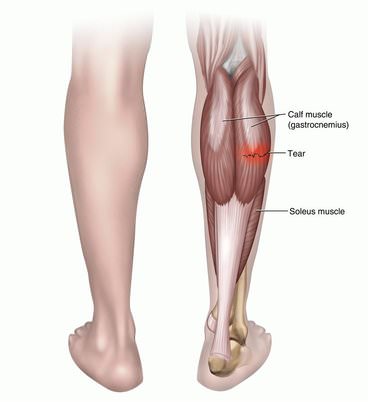The gastrocnemius is the main calf muscle, the muscle easily seen if we look at an athlete from behind. The commonest cause of calf muscle pain is a muscle strain from sport or vigorous activity.
Calf Anatomy
The gastrocnemius (GAS-TROCK-NEEM-EE-US) is a powerful muscle situated at the back of the lower leg. The upper part is made up of two parts, the medial head and the lateral head. They originate above the knee from the femoral condyles (the large prominences at the bottom of the thigh) and pass down until they join the soleus muscle to make up the Achilles tendon.
The gastrocnemius is a powerful muscle that allows us to push forwards forcefully and quickly such as in fast walking, running and sprinting. Because it originates above the knee, the position of the knee is important in a sudden onset of leg pain as in a gastrocnemius tear.
Who Gets A Medial Calf Strain?
Calf strains are much more common in men, particularly during sports activities in men from their 30s to their 50s. A pulled calf muscle typically happens suddenly but up to a fifth of patients may indicate their calf felt tight for a few days beforehand.
People who are over 30 and still strong and active may be at risk because they do not maintain fitness and flexibility over time. As they become “weekend warriors” they subject their calf muscles to unaccustomedly high levels of force and a muscle strain occurs.
How Does A Calf Strain Occur?
The commonest way a calf strain occurs involves the leg being in a position where the knee is straight and the ankle pulled upwards. The gastrocnemius muscle then contracts when it is in an already lengthened state, stressing the muscle too greatly and causing a torn calf muscle. An example is when someone is doing a tennis stroke, when the back leg is often in the position described above. A strain can also occur when lifting a heavy weight or pushing a car.
Strains typically occur at the junction between the muscle and the tendon, known as the musculotendinous junction.
Symptoms Of A Calf Sprain
- Patients often say they could hear a “pop” as the muscle tore
- The calf feels as if hit by a hard object. Squash players often initially suspect they have been hit by their opponent’s racket
- Severe and sudden onset of calf pain, inability to walk normally and limited ankle movement
- The calf may swell, sometimes extending down the leg, and bruising is common
Treatment for Calf Strain
Physiotherapy is the main treatment for calf strains, with sports physiotherapists skilled in assessment and management of acute injuries such as calf strains.
Acute strains are managed using the PRICE protocol:
- Protection. Crutches and heel raises are important if the person is unable to walk normally
- Rest from aggravating activities and limitation of any stretch on the damaged area
- Icing the area regularly
- Compression bandages may be used, with care not to compromise the circulation of the lower leg
- Elevation of the leg will help prevent further swelling.
- A brace may be used to keep the resting ankle in as pulled up a position as it tolerated as this has been shown to speed up healing
- Toe pointing exercises may be performed provided significant pain is not present.
As the calf recovers the physiotherapist will introduce active exercises and progress to light resistance, reducing the height of the heel raises, adding stationary bike work and resisted heel raises. Once the range of movement and strength are good and there is no pain, normal weight-bearing and balance training can be started, leading to sports-specific activities as required.
In the longer term, once the pain and restrictions have all eased and the person is back to full fitness, stretching and strengthening can continue. This allows any scar tissue to heal in a lengthened position and reduces the risk of re-injury when a scar heals in a tight fashion.
References:
- Orchard JW et al. Exact moment of a gastrocnemius muscle strain captured on video. Case Report. Br J Sports Med 2002;36:3 222-223. http://bjsm.bmj.com/content/36/3/222.full
- Patient Information Sheet – Calf strain. Dr. Chris Milne. BMJ Blogs. http://blogs.bmj.com/bjsm/2008/10/16/patient-information-sheet-calf-strain/
- Medial Gastrocnemius Strain. Medscape.
Last Review Date: 25-02-2020
Next Review Date: 25-02-2022

